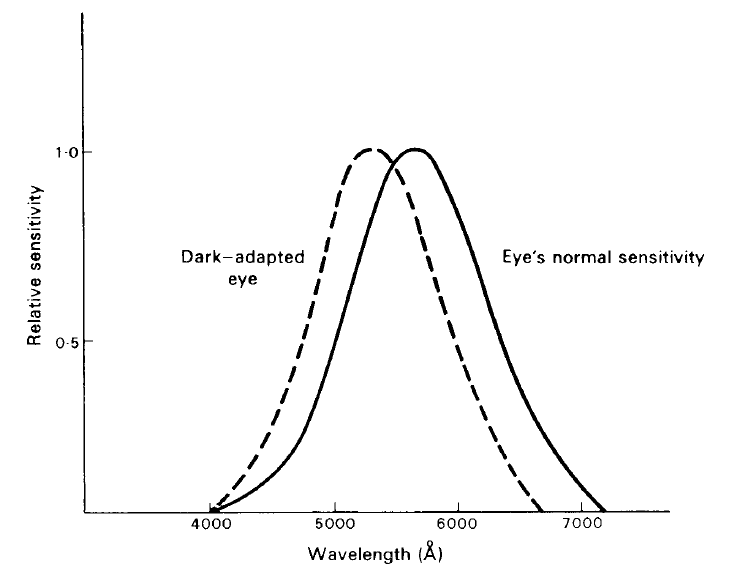


 الفيزياء الكلاسيكية
الفيزياء الكلاسيكية
 الكهربائية والمغناطيسية
الكهربائية والمغناطيسية
 علم البصريات
علم البصريات
 الفيزياء الحديثة
الفيزياء الحديثة
 النظرية النسبية
النظرية النسبية
 الفيزياء النووية
الفيزياء النووية
 فيزياء الحالة الصلبة
فيزياء الحالة الصلبة
 الليزر
الليزر
 علم الفلك
علم الفلك
 المجموعة الشمسية
المجموعة الشمسية
 الطاقة البديلة
الطاقة البديلة
 الفيزياء والعلوم الأخرى
الفيزياء والعلوم الأخرى
 مواضيع عامة في الفيزياء
مواضيع عامة في الفيزياء|
Read More
Date: 5-9-2020
Date: 16-8-2020
Date: 2-9-2020
|
The eye as a detector
Very briefly, the main elements of the eye consist of a pupil which controls the amount of light which enters it, a lens and a photosensitive surface called the retina on to which the lens focuses the images. The brain converts the sensations of the retina to give the observer the impression of there being objects set out in space.
There is wide variation in the different properties of the eye according to the individual and the discussion here is related to that of an average observer. The daytime spectral response or visibility curve of an average eye is illustrated in figure 18.1. It can be seen that the eye is capable of covering the optical range from 4000 to 7000 ˚A and this range is known as the visible spectrum. The eye is unable to store or make a permanent record of any image. The image it produces can be considered to be instantaneous. If the light-level is below a certain threshold, then the eye does not respond. When the eye has been working in conditions of normal illumination and is then removed to a darkened environment, such as might be expected for night observations, its sensitivity undergoes changes,

Figure 1. The relative spectral sensitivity of an average human eye; the dotted curve illustrates the Purkinje effect, showing how the sensitivity curve is modified when the eye is dark-adapted.
lowering the threshold of visibility. These changes take about half an hour before the sensitivity settles to its improved value and, in this condition, the eye is said to be dark-adapted. There are two causes which give rise to dark-adaption. One of them is due to the automatic expansion of the pupil, so allowing a larger collecting area for the incoming radiation. The other, providing the greater effect, is due to the biochemical changes occurring in the retina itself. Under dark-adapted conditions and with a little practice, it is apparent that the eye’s sensitivity depends on the direction of the object. The minimum of sensitivity occurs when the eye is looking straight ahead and, by using averted vision, it may be possible to detect faint objects which disappear when looked at directly.
Dark adaption also gives rise to changes in the spectral sensitivity of the eye. The peak in sensitivity moves by approximately 500 ˚A towards the blue end of the spectrum and the eye loses its sensitivity to red wavelengths. This change is known as the Purkinje effect and the dotted curve in figure 1 illustrates an average spectral sensitivity under dark-adapted conditions. Prior to the application of the photographic plate, photoelectric detectors and CCD devices, the eye was used to judge brightness differences between astronomical objects. The values of differences which might be detected depend on several factors such as the colours of the objects for the comparison and their absolute brightnesses. With practice, brightness differences of a few per cent can be detected. It is not really convenient to assign a quantum efficiency to the eye but by considering its ability just to be able to detect a sixth magnitude star, it can be said that it is necessary to receive a few hundred photons per second to register a star image.
It is difficult to give a hard and fast rule for the resolving power of the eye as it depends critically on the type of observation which is being attempted. However, under ordinary circumstances, the average eye is able to resolve angles of one minute of arc. This figure corresponds to the resolving power which might be expected by an aperture of the size of the pupil ∼2·5 mm, a typical
diameter when operating in an everyday environment, and to the sizes of the detector elements which make up the retina. Under special circumstances, the eye has special properties of high vernier acuity and symmetry judgment allowing even smaller angles to be resolved. It is capable of resolving a break in a line which might correspond to an angular difference of ten seconds of arc. This ability is put to use in measuring instruments whose settings are read off a vernier scale. Although such instruments are now no longer used on a telescope, they may still be found on ancillary equipment which might be employed to analyse astronomical data recorded, say, on a photographic plate. The continuing advance of new techniques and automation, however, will eventually displace the use of the eye for all data reductions. As well as taking advantage of the eye’s symmetry judgment in general measuring instruments, it was this ability which made the eye useful for making classical double-star measurements on the telescope.



|
|
|
|
التوتر والسرطان.. علماء يحذرون من "صلة خطيرة"
|
|
|
|
|
|
|
مرآة السيارة: مدى دقة عكسها للصورة الصحيحة
|
|
|
|
|
|
|
نحو شراكة وطنية متكاملة.. الأمين العام للعتبة الحسينية يبحث مع وكيل وزارة الخارجية آفاق التعاون المؤسسي
|
|
|